Several options exist for ensuring the durability of vehicles. One of the most inexpensive ones is painting the car. This protects its metallic components from several elements that will affect them. Since most car owners know this, they are not afraid of spending top dollar on getting the best paint job. This means opening an automotive paint business is one of the most lucrative ventures. You nonetheless need to invest in the right equipment to guarantee your clients’ satisfaction.
Automotive paint booths are your best choices for the best quality spray painting jobs. These booths will contain hazardous elements like VOCs and overspray and enclose your paint to guarantee optimal paint while keeping it contaminant-free. One aspect you should pick for your task is the method of spray painting you will use. Multiple spray-painting techniques exist because it is a versatile and inexpensive paint application option. Here are tidbits to guide you on picking the ideal one for your business.
Air Atomized Spray
This marks the conventional technique for spray painting. Your applicator will comprise a conventional spray gun that will combine liquid flow with compressed air to generate a pressurized spray that will coat the car. The gun can be customized and adjusted to suit several applications and will suffice for almost all substrate types. The air atomized spray technology, however, results in paint loss and poor paint transfer on the car you are working on.
Airless Spray

This technique forces your liquid paint coating through a narrow applicator opening to generate pressure instead of mixing compressed air and liquid paint. Airless spraying will propel paint particles at lower velocities compared to air atomized sprays and thus minimizes paint loss through overspray. This technique will, however, need advanced operator skills and considerable equipment maintenance. It, therefore, attracts higher costs compared to other spray-painting alternatives.
Electrostatic Spray
This is a relatively new technology that guarantees better paint transfer efficiency than other alternatives. The machines used for electrostatic spraying will charge paint particles with high voltages. This causes their attraction to the surface being painted and wrap around it to maximize transfer efficiency. This way, you can get a solid and smooth paint coat with minimal energy even when painting parts with contours and corners. Electrostatic sprays are meant for use with specific paints. These are those with a particular conductivity level and chemical compositions. Even so, electrostatic spraying has considerable fire risk.
HVLP (High-Volume, Low-Pressure) Spray
HVLP spraying will use spray gun atomization technology. This propels considerable amounts of low-pressure air to your gun applicator. The methods will yield minimal overspray and blowback because the paint is sprayed at a low velocity. Though HVLP has a high transfer efficiency for your paints, you need skilled painters to handle it.
The ideal paint booth for the above spray-painting techniques comprises several elements. These include panel structures that channel air, motorized fans, an extraction chimney, and a specialized electrical control cabinet. The fans and extraction chimney will evacuate the polluted air in your booth. Heating and filtration equipment are also essential to guarantee the safety and efficacy of your paint booth.


